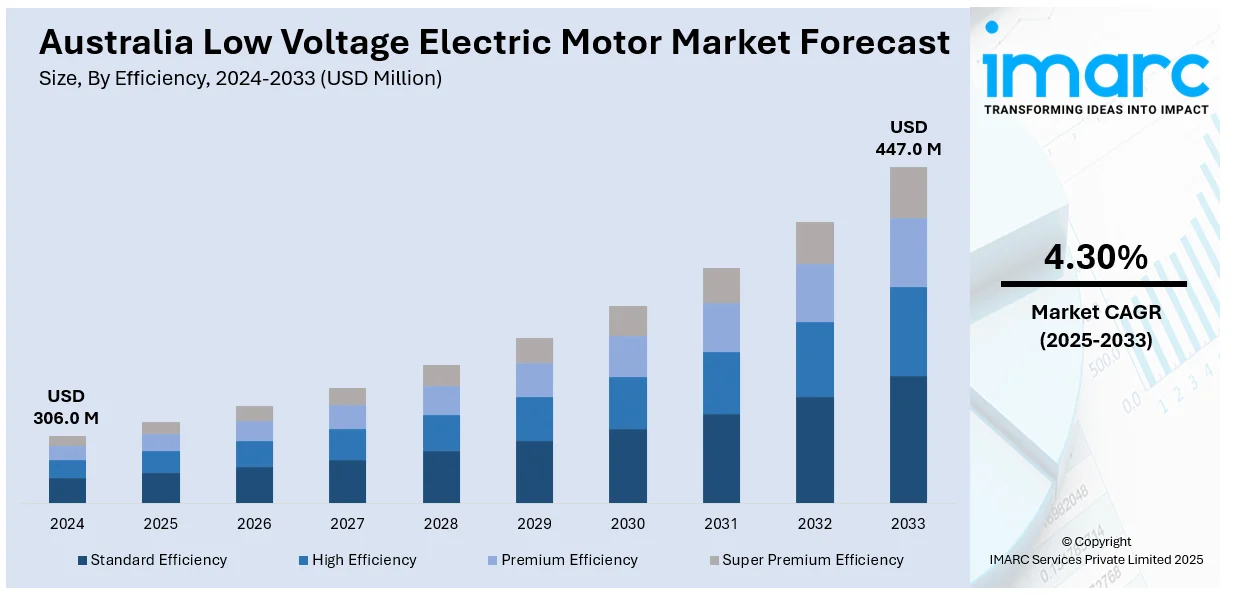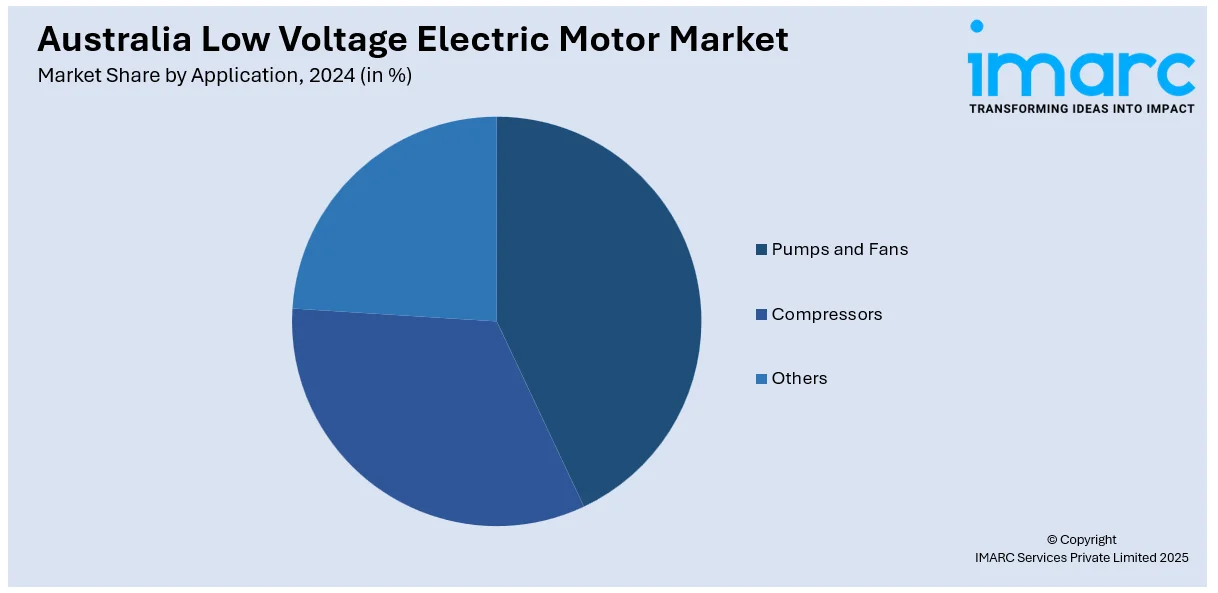
Australia Low Voltage Electric Motor Market Size, Share, Trends and Forecast by Efficiency, Application, End-Use Industry, and Region, 2025-2033
Australia Low Voltage Electric Motor Market Overview:
The Australia low voltage electric motor market size reached USD 306.0 Million in 2024. Looking forward, IMARC Group expects the market to reach USD 447.0 Million by 2033, exhibiting a growth rate (CAGR) of 4.30% during 2025-2033. The market share is expanding, driven by the rising development of smart buildings and eco-friendly infrastructure, which is creating the need for advanced and efficient electric motors, along with the increasing adoption of electric vehicles (EVs).
|
Report Attribute
|
Key Statistics
|
|---|---|
|
Base Year
|
2024 |
|
Forecast Years
|
2025-2033
|
|
Historical Years
|
2019-2024
|
| Market Size in 2024 | USD 306.0 Million |
| Market Forecast in 2033 | USD 447.0 Million |
| Market Growth Rate 2025-2033 | 4.30% |
Australia Low Voltage Electric Motor Market Trends:
Increasing expenditure on infrastructure and construction projects
Rising investments in infrastructure and construction projects are offering a favorable Australia low voltage electric motor market outlook. In September 2024, Iberdrola, the prominent electric utility company, started constructing a massive solar energy and battery storage (BESS) facility in Australia, set to achieve a total capacity of 556 megawatts (MW). It is anticipated to be finished by mid-2026. As new buildings, highways, tunnels, and industrial zones are being built, electric motors are in high demand to power a variety of items, inculcating heating, ventilation, and air conditioning (HVAC) systems, elevators, pumps, conveyors, and heavy machinery. Low voltage electric motors are a popular choice for these applications due to their efficiency, dependability, and ease of installation. Construction sites rely on a wide range of powered tools and systems, and electric motors help to keep these equipment working smoothly and safely. Furthermore, as engineers strive to fulfill higher energy optimization criteria, they utilize low voltage electric motors with high efficiency ratings to reduce power usage. With the expansion of smart buildings and eco-friendly infrastructure, there is a rise in the need for motors that can work with automation systems and sensors. Regional development projects are also driving the demand for low voltage electric motors in water systems and public transportation systems.

To get more information on this market, Request Sample
Growing utilization of EVs
The increasing adoption of EVs is impelling the Australia low voltage electric motor market growth. According to the Electric Vehicle Council, EV sales rose in Australia, accounting for nearly one out of every 10 cars sold in 2024, with their popularity anticipated to nearly double in the next two years. As more people are shifting towards EVs, the need for components like low voltage electric motors is high. These motors are employed in various parts of EVs to aid in propulsion and powering auxiliary systems like cooling fans, power windows, pumps, and HVAC systems. Automakers are utilizing low voltage electric motors since they are compact, efficient, and reliable. With the rise in EV manufacturing and assembly locally, there is a growing requirement for these motors within the supply chain. Charging infrastructure and service stations that cater to EVs also use these motors in different support systems. As government policies continue to promote greener transportation and more charging stations are being established around the country, the overall EV ecosystem gets stronger. This is making low voltage electric motors an essential part of the industry.
Australia Low Voltage Electric Motor Market Segmentation:
IMARC Group provides an analysis of the key trends in each segment of the market, along with forecasts at the regional level for 2025-2033. Our report has categorized the market based on efficiency, application, and end-use industry.
Efficiency Insights:
- Standard Efficiency
- High Efficiency
- Premium Efficiency
- Super Premium Efficiency
The report has provided a detailed breakup and analysis of the market based on the efficiency. This includes standard efficiency, high efficiency, premium efficiency, and super premium efficiency.
Application Insights:

- Pumps and Fans
- Compressors
- Others
A detailed breakup and analysis of the market based on the application have also been provided in the report. This includes pumps and fans, compressors, and others.
End-Use Industry Insights:
- Commercial HVAC Industry
- Food, Beverage and Tobacco Industry
- Mining Industry
- Utilities
- Others
The report has provided a detailed breakup and analysis of the market based on the end-use industry. This includes commercial HVAC industry, food, beverage and tobacco industry, mining industry, utilities, and others.
Regional Insights:
- Australia Capital Territory & New South Wales
- Victoria & Tasmania
- Queensland
- Northern Territory & Southern Australia
- Western Australia
The report has also provided a comprehensive analysis of all the major regional markets, which include Australia Capital Territory & New South Wales, Victoria & Tasmania, Queensland, Northern Territory & Southern Australia, and Western Australia.
Competitive Landscape:
The market research report has also provided a comprehensive analysis of the competitive landscape. Competitive analysis such as market structure, key player positioning, top winning strategies, competitive dashboard, and company evaluation quadrant has been covered in the report. Also, detailed profiles of all major companies have been provided.
Australia Low Voltage Electric Motor Market News:
- In January 2024, A1 Electric Motors announced that it became an accredited Channel Partner for the supply, installation, and maintenance of various ABB motor technologies in Australia. The firm aimed to stock and supply a wide assortment of ABB’s IEC low voltage motors, ultra-premium synchronous reluctance (SynRM) motors, and smart sensors for remote monitoring of conditions.
Australia Low Voltage Electric Motor Market Report Coverage:
| Report Features | Details |
|---|---|
| Base Year of the Analysis | 2024 |
| Historical Period | 2019-2024 |
| Forecast Period | 2025-2033 |
| Units | Million USD |
| Scope of the Report |
Exploration of Historical Trends and Market Outlook, Industry Catalysts and Challenges, Segment-Wise Historical and Future Market Assessment:
|
| Efficiencies Covered | Standard Efficiency, High Efficiency, Premium Efficiency, Super Premium Efficiency |
| Applications Covered | Pumps and Fans, Compressors, Others |
| End-Use Industries Covered | Commercial HVAC Industry, Food, Beverage and Tobacco Industry, Mining Industry, Utilities, Others |
| Regions Covered | Australia Capital Territory & New South Wales, Victoria & Tasmania, Queensland, Northern Territory & Southern Australia, Western Australia |
| Customization Scope | 10% Free Customization |
| Post-Sale Analyst Support | 10-12 Weeks |
| Delivery Format | PDF and Excel through Email (We can also provide the editable version of the report in PPT/Word format on special request) |
Key Questions Answered in This Report:
- How has the Australia low voltage electric motor market performed so far and how will it perform in the coming years?
- What is the breakup of the Australia low voltage electric motor market on the basis of efficiency?
- What is the breakup of the Australia low voltage electric motor market on the basis of application?
- What is the breakup of the Australia low voltage electric motor market on the basis of end-use industry?
- What is the breakup of the Australia low voltage electric motor market on the basis of region?
- What are the various stages in the value chain of the Australia low voltage electric motor market?
- What are the key driving factors and challenges in the Australia low voltage electric motor market?
- What is the structure of the Australia low voltage electric motor market and who are the key players?
- What is the degree of competition in the Australia low voltage electric motor market?
Key Benefits for Stakeholders:
- IMARC’s industry report offers a comprehensive quantitative analysis of various market segments, historical and current market trends, market forecasts, and dynamics of the Australia low voltage electric motor market from 2019-2033.
- The research report provides the latest information on the market drivers, challenges, and opportunities in the Australia low voltage electric motor market.
- Porter's five forces analysis assist stakeholders in assessing the impact of new entrants, competitive rivalry, supplier power, buyer power, and the threat of substitution. It helps stakeholders to analyze the level of competition within the Australia low voltage electric motor industry and its attractiveness.
- Competitive landscape allows stakeholders to understand their competitive environment and provides an insight into the current positions of key players in the market.
Need more help?
- Speak to our experienced analysts for insights on the current market scenarios.
- Include additional segments and countries to customize the report as per your requirement.
- Gain an unparalleled competitive advantage in your domain by understanding how to utilize the report and positively impacting your operations and revenue.
- For further assistance, please connect with our analysts.
 Request Customization
Request Customization
 Speak to an Analyst
Speak to an Analyst
 Request Brochure
Request Brochure
 Inquire Before Buying
Inquire Before Buying




.webp)




.webp)












